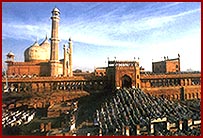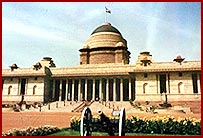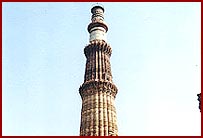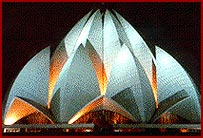Delhi
A
capital city enclosing the image of ancient and modern India.
Places to visit in Delhi: Red
Fort, Jama
Masjid, Chandni
Chowk, Rashtrapati
Bhawan, India
Gate, Rajghat,
Birla
Mandir, Qutub
Minar, Lotus
Temple, Iskcon
Temple
Introduction: The Capital
city of the country and one of the largest cities in India, Delhi has a
history extending back over three millennia.The strategic location of
Delhi, between the Aravalli hills and the river Yamuna, had attracted the
attention of almost every King or Conqueror in this part of the world. The
earliest reference to Delhi as a settlement is made in the Hindu epic,
Mahabharata, which states that the Pandavas founded a city called �Indraprastha�,
besides the river Yamuna in 1450 BC. Ever since then, Conquerors from
North treated Delhi as a gateway to the Indian sub-continent.
 Delhi
today is one of the most elegant capitals in the world. Here one can see,
the mingling of many cultures, languages, tradition and peoples into one
united Nation. Delhi welcomes both the pleasure seeker and the mystic.
�Lose yourself in Delhi� says Khushwant Singh, for �You may find its
soul and your own�.
Delhi
today is one of the most elegant capitals in the world. Here one can see,
the mingling of many cultures, languages, tradition and peoples into one
united Nation. Delhi welcomes both the pleasure seeker and the mystic.
�Lose yourself in Delhi� says Khushwant Singh, for �You may find its
soul and your own�.
Contact for any kind of
information about Delhi
Red Fort: Red
Fort is laid out along the river Yamuna as an irregular octagon,
surrounded by a wall of about 2.4 km in circumference and is built of red
sandstone. The Mughal King Shah Jahan transferred the capital from Agra to
Delhi and the Fort was completed in 1648. The Fort has Diwan-e-Am, and
Diwan-e-Khas where the king would grant audience to the public and would
grant audience to important people respectively . Besides this is the Rang
Mahal, the water cooled Apartment for the royal ladies.
Jama Masjid:
This mosque, the largest in India, was built by Shah Jahan in 1956 AD.
Situated near the Red Fort in Old Delhi, the Jama Masjid has a sitting
capacity of more than 20,000.  Crowned
by 3 onion domes and tapering minarets made of marble and slate, this
architectural beauty is also a place of religious significance. The view
from the top of the minarets is excellent.
Crowned
by 3 onion domes and tapering minarets made of marble and slate, this
architectural beauty is also a place of religious significance. The view
from the top of the minarets is excellent.
Chandni Chowk:
Today the centrepiece of Old Delhi, it was the pulse of Mughal Delhi�s
commercial life. Designed by Jahanara Begum, the favourite daughter of
Shah Jahan in 1648, this place was once filled with shops and houses of
wealthy merchants and noblemen. A narrow water course once flowed down the
middle of this road, carrying water to the palaces. Its winding narrow
lanes are now filled with a variety of shops ranging from sweet stalls to
jewellery, textile and leather shops.
 Rashtrapati
Bhawan: This official residence of the President of India was
formerly known as the Viceregal Palace. Rashtrapati Bhawan is the
highlight of Lutyen's New Delhi and was completed in 1929 at a cost of
Rs.12,53,000. Located in an area of 130 hectares, the palace has 340
rooms. At one time, 2,000 people were required to look after the building
and serve the Viceroy's household. It has an impressive garden called the MUGHAL
GARDENS, which is open to public twice in a year, usually in February
and March.
Rashtrapati
Bhawan: This official residence of the President of India was
formerly known as the Viceregal Palace. Rashtrapati Bhawan is the
highlight of Lutyen's New Delhi and was completed in 1929 at a cost of
Rs.12,53,000. Located in an area of 130 hectares, the palace has 340
rooms. At one time, 2,000 people were required to look after the building
and serve the Viceroy's household. It has an impressive garden called the MUGHAL
GARDENS, which is open to public twice in a year, usually in February
and March.
Contact for any kind of
information about Delhi
India Gate:
Straight down the road from Rashtrapati Bhavan is India Gate which
is primarily a memorial to unknown soldiers. Designed by Lutyens, the 42
meter high structure is a war memorial in honour of soldiers who died
during the Second World War. The structure has an eternal flame (Amar
Jawan Jyoti) to honour the memory of the unknown soldiers.
Rajghat: Located
near the banks of the Yamuna River, Rajghat is a serene monument. It marks
the site where Mahatma Gandhi was cremated after his assassination. The
samadhi is surrounded by wide lawns and a garden with fountains and exotic
trees that create a perfect ambience for meditation. Visitors come here to
meditate on the Mahatma and the meaning of his life.
Birla Mandir:
This is one of the landmarks in New Delhi - the capital of India. Built in
the 20th century by the Birla family of industrialists, it stands apart
from other temples in terms of concept and construction. The presiding
deity here is Lakshmi Narain (Vishnu). The highest tower in the temple
reaches a height of 165 feet while the ancillary towers reach 116 feet.
The Geeta Bhavan, a hall is adorned with beautiful paintings depicting
scenes from Indian mythology. There is also a temple dedicated to Buddha
in this complex with fresco paintings describing his life and work.
Qutub Minar:
Qutab-ud-din Aibak, the first Muslim ruler of Delhi, commenced the
construction of the Qutub Minar in 1193 AD. The development of
architectural styles from Aibak to Tuglak are quite evident in the minar.  The
238 feet high Qutub Minar is 47 feet at the base and tapers to 9 feet at
the apex. The main mosque comprises an inner and outer courtyard, of which
the inner one is surrounded by an exquisite colonnade, the pillars of
which are made of richly decorated shafts.
The
238 feet high Qutub Minar is 47 feet at the base and tapers to 9 feet at
the apex. The main mosque comprises an inner and outer courtyard, of which
the inner one is surrounded by an exquisite colonnade, the pillars of
which are made of richly decorated shafts.
Among the ruins in the Qutub Complex, the Quwat ul Islam Masjid is one of
the most magnificent mosques in the world. The building material for this
mosque is provided by demolishing many Hindu and Jain Temples in this
area. Built in 1197, this mosque is one of the finest blend of Hindu and
Islamic architecture.
Contact for any kind of
information about Delhi
In the courtyard of the Quwat ul Islam Masjid, is a 7m high Iron Pillar
- one of Delhi's most curious antiquities. Belonging to the Gupta Age, the
pillar contains Sanskrit inscriptions, which state its history.
 Lotus
Temple: This gleaming white structure, shaped like a Lotus, is
made of marble, cement, dolomite and sand. Located on Bahapur Hill, the
Lotus Temple is meant for the worship of God, irrespective of caste,
creed, race or nation. Visitors are requested to maintain silence inside
the temple premises. A visit to the Bahai Temple also known as Lotus
Temple is a must both for the tourists and the people in search of peace
and tranquillity.
Lotus
Temple: This gleaming white structure, shaped like a Lotus, is
made of marble, cement, dolomite and sand. Located on Bahapur Hill, the
Lotus Temple is meant for the worship of God, irrespective of caste,
creed, race or nation. Visitors are requested to maintain silence inside
the temple premises. A visit to the Bahai Temple also known as Lotus
Temple is a must both for the tourists and the people in search of peace
and tranquillity.
Iskcon Temple:
Iskcon Temple in Delhi is reputed as one of the largest temple complexes
in India. The elegantly built complex is located on a hill and is
dedicated to Lord Krishna and Radha. The hall of the temple is centrally
air-cooled with a capacity to accommodate about 1,500 people. There are
beautiful paintings of Russian artists on the different past times of
Radha Krishna, Sita, Ram, Laxman, Hanuman and Chaitanya Mahaprabhu.


 Delhi
today is one of the most elegant capitals in the world. Here one can see,
the mingling of many cultures, languages, tradition and peoples into one
united Nation. Delhi welcomes both the pleasure seeker and the mystic.
�Lose yourself in Delhi� says Khushwant Singh, for �You may find its
soul and your own�.
Delhi
today is one of the most elegant capitals in the world. Here one can see,
the mingling of many cultures, languages, tradition and peoples into one
united Nation. Delhi welcomes both the pleasure seeker and the mystic.
�Lose yourself in Delhi� says Khushwant Singh, for �You may find its
soul and your own�. Crowned
by 3 onion domes and tapering minarets made of marble and slate, this
architectural beauty is also a place of religious significance. The view
from the top of the minarets is excellent.
Crowned
by 3 onion domes and tapering minarets made of marble and slate, this
architectural beauty is also a place of religious significance. The view
from the top of the minarets is excellent. Rashtrapati
Bhawan: This official residence of the President of India was
formerly known as the Viceregal Palace. Rashtrapati Bhawan is the
highlight of Lutyen's New Delhi and was completed in 1929 at a cost of
Rs.12,53,000. Located in an area of 130 hectares, the palace has 340
rooms. At one time, 2,000 people were required to look after the building
and serve the Viceroy's household. It has an impressive garden called the MUGHAL
GARDENS, which is open to public twice in a year, usually in February
and March.
Rashtrapati
Bhawan: This official residence of the President of India was
formerly known as the Viceregal Palace. Rashtrapati Bhawan is the
highlight of Lutyen's New Delhi and was completed in 1929 at a cost of
Rs.12,53,000. Located in an area of 130 hectares, the palace has 340
rooms. At one time, 2,000 people were required to look after the building
and serve the Viceroy's household. It has an impressive garden called the MUGHAL
GARDENS, which is open to public twice in a year, usually in February
and March. The
238 feet high Qutub Minar is 47 feet at the base and tapers to 9 feet at
the apex. The main mosque comprises an inner and outer courtyard, of which
the inner one is surrounded by an exquisite colonnade, the pillars of
which are made of richly decorated shafts.
The
238 feet high Qutub Minar is 47 feet at the base and tapers to 9 feet at
the apex. The main mosque comprises an inner and outer courtyard, of which
the inner one is surrounded by an exquisite colonnade, the pillars of
which are made of richly decorated shafts. Lotus
Temple: This gleaming white structure, shaped like a Lotus, is
made of marble, cement, dolomite and sand. Located on Bahapur Hill, the
Lotus Temple is meant for the worship of God, irrespective of caste,
creed, race or nation. Visitors are requested to maintain silence inside
the temple premises. A visit to the Bahai Temple also known as Lotus
Temple is a must both for the tourists and the people in search of peace
and tranquillity.
Lotus
Temple: This gleaming white structure, shaped like a Lotus, is
made of marble, cement, dolomite and sand. Located on Bahapur Hill, the
Lotus Temple is meant for the worship of God, irrespective of caste,
creed, race or nation. Visitors are requested to maintain silence inside
the temple premises. A visit to the Bahai Temple also known as Lotus
Temple is a must both for the tourists and the people in search of peace
and tranquillity.